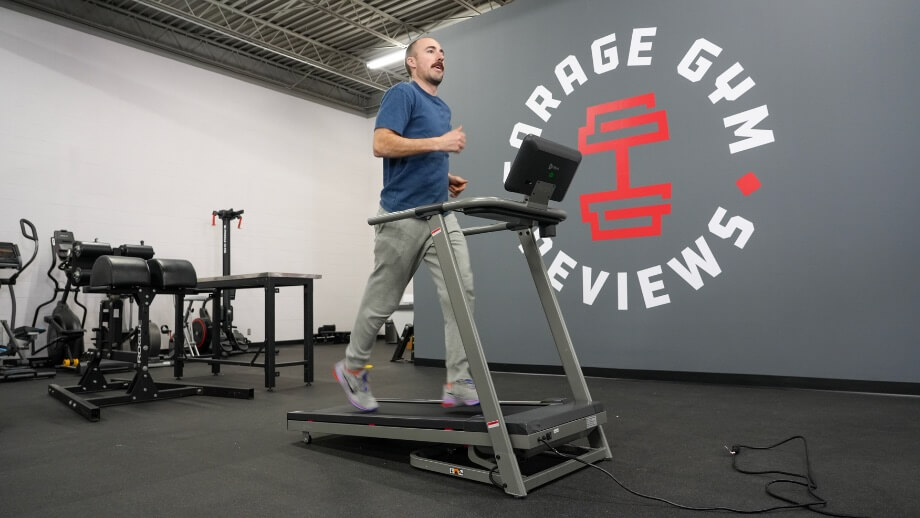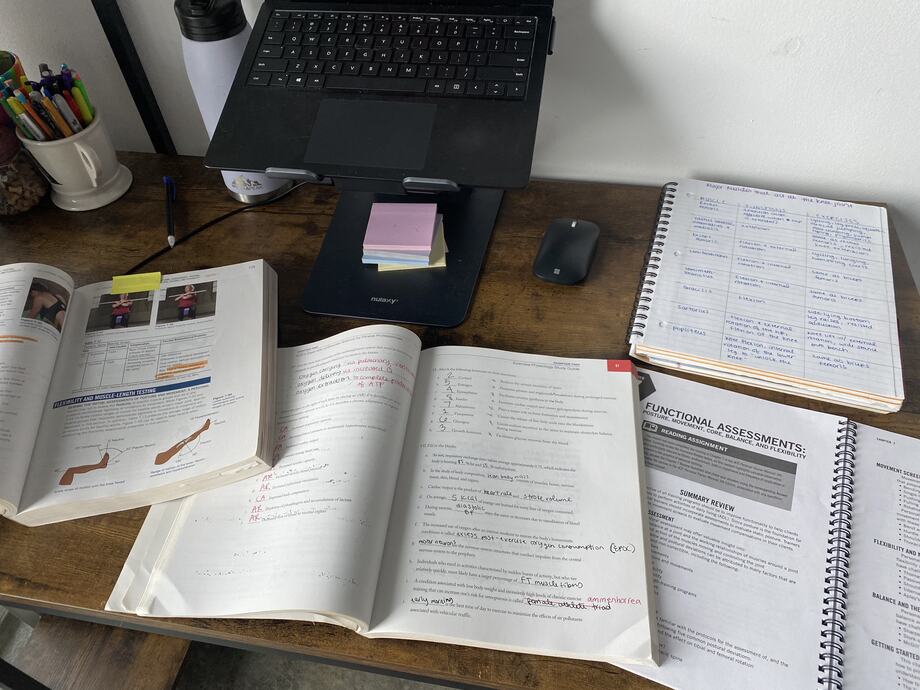Running a full marathon is a token of competence in the endurance world. Here’s how to join the ranks.
Anyone who’s crossed the finish line of a foot race knows that it feels dang good. If you experience the elusive runner’s high, even better. There is a reason runners continue to return to the pavement even after writhing on the ground post-race, suffering cramps, and tending to blisters.
So maybe you’re here today because you’ve officially gotten hooked on running and you’re ready to up the ante. Maybe you’re looking to cross off a bucket list item. Or maybe you’re running for a cause.
Whatever your reason for Googling a marathon training plan, our experienced runners have the need-to-know before toeing the start line.
What to Expect During Your First Marathon
Pain. Cramps. Hunger. Sunburn. Blisters. Thirst.
These are all things that can happen when you embark on your journey to a marathon and on marathon race day. However, you’ll be glad to know that they’re all—yes, all—avoidable. Except maybe pain, because to be quite honest, I don’t think anyone gets away with running 26.2 miles with no pain.
But also: Expect to feel proud, accomplished, and extremely gratified!
Seeing—and feeling—all of your hard work culminate at the finish line is a feeling like no other.
All that said, here are some practical tips you should know before race day:
- Do not race in new gear. Race in the gear you trained in, lest you suffer chafing and blisters and soreness.
- Eat. A lot. You will become so hungry during marathon training and you will be hungry before, during, and after the race. We cover fueling in more detail below, but honor your hunger and eat up!
- Don’t hesitate to invest in the gear that makes a difference. You don’t need the most expensive version of everything, but know that shoes, socks, sports bras, shorts, running packs, sunglasses, and hats can make a huge difference—positive or negative—when you’re running 26.2 miles.
- Learn how to get comfortable with your thoughts and get comfortable with being bored. Long-distance running can become monotonous. Running in groups during training and on race day can break up the monotony.
Related: Half-Marathon Training Plan
Types of Marathon Training Runs
Here’s a breakdown of the four main types of training runs you’ll likely come across while preparing for a marathon.
Speed Work
Speed work intends to make you a faster runner. Specifically, speed work for marathon training is designed to increase your work capacity over distinct periods of time, thereby increasing your long-distance stamina.
Long Runs
Long runs are… Long. For marathon training, long runs can range from anything over a 10K (6.2 miles) up to a full 26 miles. For the most part, experienced marathon runners don’t exceed 20 miles in a given training cycle leading up to a race. But for beginners, it’s important to reach the full marathon mileage at least once before your race day. Otherwise, you might be in for a serious shock to the system.
Tempo Runs
Tempo runs are designed to make you push your pace for a specified mileage. For instance, you might be told to run at your 5K pace for 4 miles (instead of the actual 5K distance of 3.1 miles). These runs are a really good opportunity to work on your mental strength and practice pushing through tough spots—which you will have to do a lot if you plan on running a marathon.
Fartlek Runs
Fartlek runs allow for some fun and flexibility in your weekly training regimen. These runs are a type of speed work, but they’re based solely on feel and don’t force you to run through any regimented prescriptions. On a Fartlek run, you’ll create your own intervals using landmarks as starting and stopping points. For example, you can “run hard to the next tree” and “run easy to the white mailbox.”
Other Components of Marathon Training
Aside from running, you’ll want to incorporate the following into your weekly schedule.
Cross-Training and Strength Training
Cross-training is critical when you are engaging in several hours of running per week. Any good running coach will tell you this. Many runners fall into the trap of thinking that more running is always better, when in reality, neglecting strength training and cross-training increases your risk of injury.
Running injuries can include shin splints, muscle strains, achilles tendonitis, IT band syndrome, plantar fasciitis, and stress fractures. Laying off the 20-milers can help you avoid such conditions.
Cross-training can include anything that isn’t running, but you’re encouraged to dedicate one day per week to strength training and one to workout recovery and mobility, which can include stretching, yoga, or other gentle, low-impact exercise.
Marathon Training Schedule
As GGR writer Ricky Goodrich so pointedly explains in our guide to marathon times, “Your training schedule can’t be something you might adhere to or might not depending on how much you drank last night.”
I couldn’t have said it better myself.
Marathon training is a real commitment—more so than a half-marathon and still more so than an Olympic-distance triathlon.
To successfully complete a marathon (and not feel like you were sideswiped by a semi going 70 miles per hour) you’ll need to commit to many hours of training per week.
This is especially true if you are not yet accustomed to running longer distances, seeing as you’ll have to build up a cardiovascular base and the muscular endurance needed to support that kind of volume.
A typical marathon training schedule includes five or six days of training per week, with long runs, speed work, tempo work, and recovery runs.
A common split (and the split in our training plans provided below) is:
- Monday: Speed work
- Tuesday: Cross-training
- Wednesday: Fartlek or tempo
- Thursday: Recovery/easy run or complete rest
- Friday: Cross-training
- Saturday: Long run
- Sunday: Rest
True Beginner Marathon Training Program (6-Month Marathon Training Plan)
Well, you can stop wondering how to train for a marathon, because you’ve found your answer. This marathon running plan will have you running 25 miles in six months. Thanks to gradually increasing weekly mileage, your cardio fitness level will improve each week, and you’ll be able to handle more volume as you progress through the plan.
There are two rest days built into each week of training, and your training runs consist of a mix of easy runs, interval training, tempo runs, Fartlek runs, and long runs. There are also cross-training days built in for injury prevention.
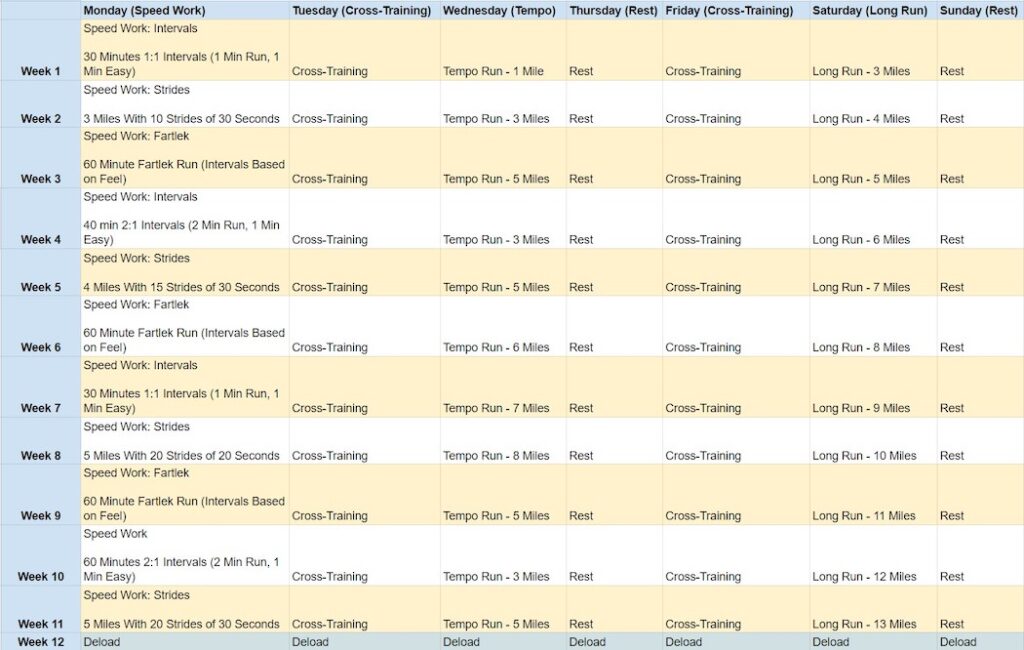
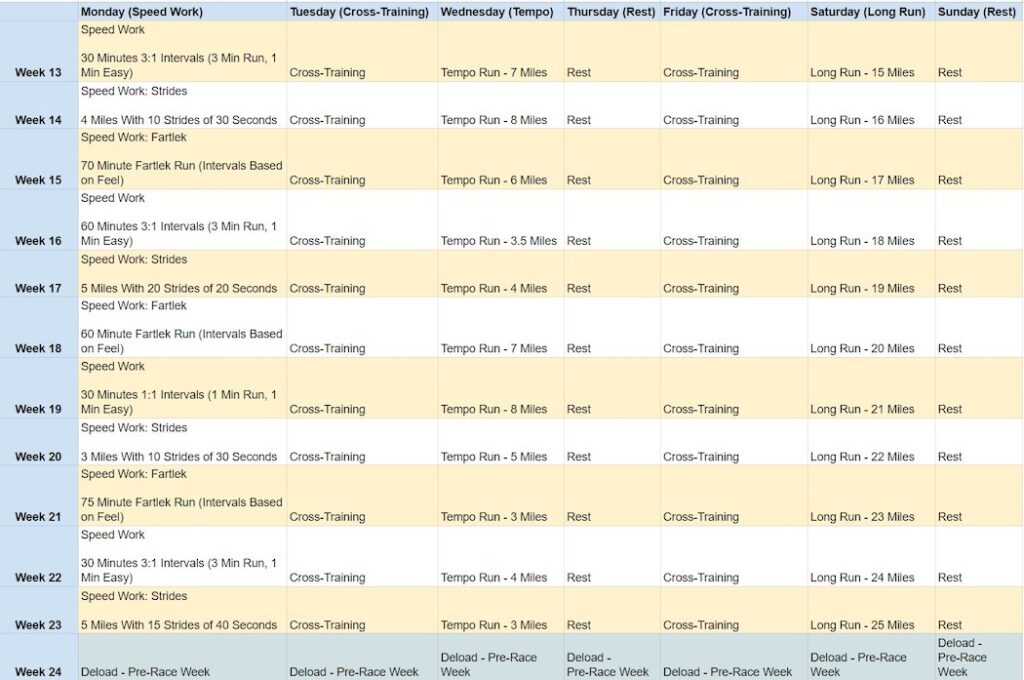
12-Week Marathon Training Plan
This plan is intended for intermediate to advanced runners who have some long-distance running experience but are looking to level-up and complete their first marathon. If you have completed a long-distance race (10 miles or more) in the last year, this might be the plan for you.
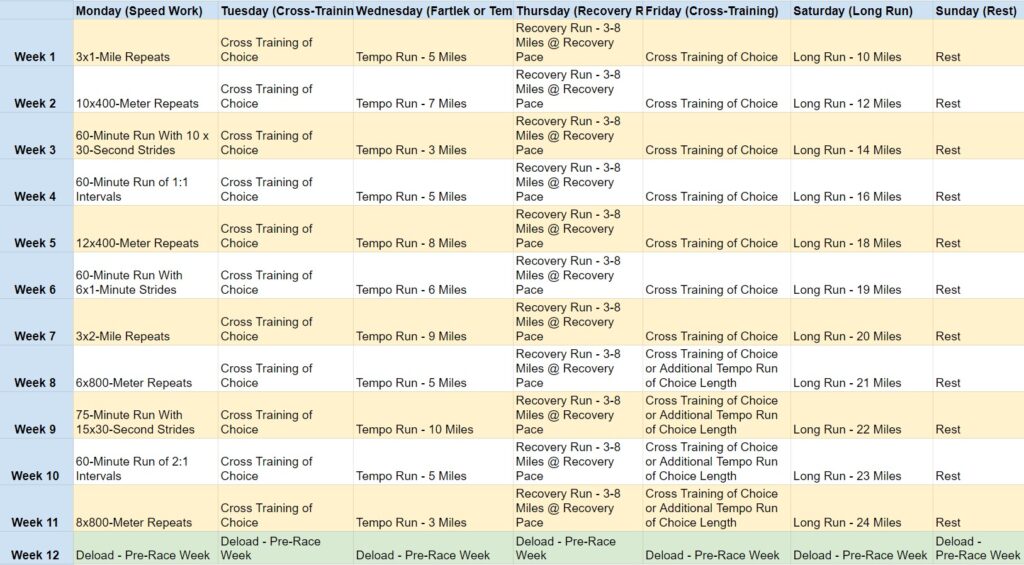
Respect the Deloads
A deload is a time period during any training cycle in which the intent is to remove physical stress from the body. This means lowering your training volume intentionally or even taking a complete week of rest.
Do not skip your deload weeks. Deloads are strategically placed in training plans to allow for time to recover and adapt to training demands. It is during these times that your body repairs tissue and replenishes energy stores.
People who run marathons tend to be the type of people who think they can never accomplish enough (hi, it’s me) so it’s common for marathon runners to want to skip deloads. In reality, prophylactic rest is one of the best ways to get stronger and faster.
Related: Signs and Symptoms of Overtraining Syndrome
A Word on Run/Walking
I want to say this outright: If your first marathon—or second, third, or all of them—is a run/walk, that is TOTALLY fine. In fact, it’s more than fine. You still did it! You traveled 26.2 miles with nothing but your running shoes (and clothes and sports drinks and energy gels, we hope), and that is something to be proud of.
I repeat: If you run/walk a marathon, you are still a marathon runner. Even if you take walking breaks, even walking a mile, you’re still in the 1% (yes, just 1%)1 of the population who can actually say they completed a marathon. And that’s something to be proud of!
Find Your Race Day Pace (Pace Calculator and Pace Chart)

Calculate Your Running Pace
Enter your stats in any 2 of the fields below to calculate the third.
Download as PDF: Running Pace Chart
| Mile Pace | 5K | 10K | 10M | Half | 15M | 20M | Marathon |
| 5:00 | 15:32 | 31:04:00 | 50:00:00 | 1:05:33 | 1:15:00 | 1:40:00 | 2:11:06 |
| 5:05 | 15:48 | 31:35:00 | 50:50:00 | 1:06:38 | 1:16:15 | 1:41:40 | 2:13:17 |
| 5:10 | 16:03 | 32:06:00 | 51:40:00 | 1:07:44 | 1:17:30 | 1:43:20 | 2:15:28 |
| 5:15 | 16:19 | 32:37:00 | 52:30:00 | 1:08:49 | 1:18:45 | 1:45:00 | 2:17:39 |
| 5:20 | 16:34 | 33:08:00 | 53:20:00 | 1:09:55 | 1:20:00 | 1:46:40 | 2:19:50 |
| 5:25 | 16:50 | 33:39:00 | 54:10:00 | 1:11:01 | 1:21:15 | 1:48:20 | 2:22:01 |
| 5:30 | 17:05 | 34:11:00 | 55:00:00 | 1:12:06 | 1:22:30 | 1:50:00 | 2:24:12 |
| 5:35 | 17:21 | 34:42:00 | 55:50:00 | 1:13:12 | 1:23:45 | 1:51:40 | 2:26:23 |
| 5:40 | 17:36 | 35:13:00 | 56:40:00 | 1:14:17 | 1:25:00 | 1:53:20 | 2:28:34 |
| 5:45 | 17:52 | 35:44:00 | 57:30:00 | 1:15:23 | 1:26:15 | 1:55:00 | 2:30:45 |
| 5:50 | :18:07 | 36:15:00 | 58:20:00 | 1:16:28 | 1:27:30 | 1:56:40 | 2:32:57 |
| 5:55 | 18:23 | 36:46:00 | 59:10:00 | 1:17:34 | 1:28:45 | 1:58:20 | 2:35:08 |
| 6:00 | 18:38 | 37:17:00 | 1:00:00 | 1:18:39 | 1:30:00 | 2:00:00 | 2:37:19 |
| 6:05 | 18:54 | 37:48:00 | 1:00:50 | 1:19:45 | 1:31:15 | 2:01:40 | 2:39:30 |
| 6:10 | 19:10 | 38:19:00 | 1:01:40 | 1:20:50 | 1:32:30 | 2:03:20 | 2:41:41 |
| 6:15 | 19:25 | 38:50:00 | 1:02:30 | 1:21:56 | 1:33:45 | 2:05:00 | 2:43:52 |
| 6:20 | 19:41 | 39:21:00 | 1:03:20 | 1:23:02 | 1:35:00 | 2:06:40 | 2:46:03 |
| 6:25 | 19:56 | 39:52:00 | 1:04:10 | 1:24:07 | 1:36:15 | 2:08:20 | 2:48:14 |
| 6:30 | 20:12 | 40:23:00 | 1:05:00 | 1:25:13 | 1:37:30 | 2:10:00 | 2:50:25 |
| 6:35 | 20:27 | 40:54:00 | 1:05:50 | 1:26:18 | 1:38:45 | 2:11:40 | 2:52:36 |
| 6:40 | 20:43 | 41:25:00 | 1:06:40 | 1:27:24 | 1:40:00 | 2:13:20 | 2:54:48 |
| 6:45 | 20:58 | 41:57:00 | 1:07:30 | 1:28:29 | 1:41:15 | 2:15:00 | 2:56:59 |
| 6:50 | 21:14 | 42:28:00 | 1:08:20 | 1:29:35 | 1:42:30 | 2:16:40 | 2:59:10 |
| 6:55 | 21:29 | 42:59:00 | 1:09:10 | 1:30:40 | 1:43:45 | 2:18:20 | 3:01:21 |
| 7:00 | 21:45 | 43:30:00 | 1:10:00 | 1:31:46 | 1:45:00 | 2:20:00 | 3:03:32 |
| 7:05 | 22:00 | 44:01:00 | 1:10:50 | 1:32:51 | 1:46:15 | 2:21:40 | 3:05:43 |
| 7:10 | 22:16 | 44:32:00 | 1:11:40 | 1:33:57 | 1:47:30 | 2:23:20 | 3:07:54 |
| 7:15 | 22:31 | 45:03:00 | 1:12:30 | 1:35:03 | 1:48:45 | 2:25:00 | 3:10:05 |
| 7:20 | 22:47 | 45:34:00 | 1:13:20 | 1:36:08 | 1:50:00 | 2:26:40 | 3:12:16 |
| 7:25 | 23:03 | 46:05:00 | 1:14:10 | 1:37:14 | 1:51:15 | 2:28:20 | 3:14:27 |
| 7:30 | 23:18 | 46:36:00 | 1:15:00 | 1:38:19 | 1:52:30 | 2:30:00 | 3:16:38 |
| 7:35 | 23:34 | 47:07:00 | 1:15:50 | 1:39:25 | 1:53:45 | 2:31:40 | 3:18:50 |
| 7:40 | 23:49 | 47:38:00 | 1:16:40 | 1:40:30 | 1:55:00 | 2:33:20 | 3:21:01 |
| 7:45 | 24:05:00 | 48:09:00 | 1:17:30 | 1:41:36 | 1:56:15 | 2:35:00 | 3:23:12 |
| 7:50 | 24:20:00 | 48:40:00 | 1:18:20 | 1:42:41 | 1:57:30 | 2:36:40 | 3:25:23 |
| 7:55 | 24:36:00 | 49:12:00 | 1:19:10 | 1:43:47 | 1:58:45 | 2:38:20 | 3:27:34 |
| 8:00 | 24:51:00 | 49:43:00 | 1:20:00 | 1:44:53 | 2:00:00 | 2:40:00 | 3:29:45 |
| 8:05 | 25:07:00 | 50:14:00 | 1:20:50 | 1:45:58 | 2:01:15 | 2:41:40 | 3:31:56 |
| 8:10 | 25:22:00 | 50:45:00 | 1:21:40 | 1:47:04 | 2:02:30 | 2:43:20 | 3:34:07 |
| 8:15 | 25:38:00 | 51:16:00 | 1:22:30 | 1:48:09 | 2:03:45 | 2:45:00 | 3:36:18 |
| 8:20 | 25:53:00 | 51:47:00 | 1:23:20 | 1:49:15 | 2:05:00 | 2:46:40 | 3:38:29 |
| 8:25 | 26:09:00 | 52:18:00 | 1:24:10 | 1:50:20 | 2:06:15 | 2:48:20 | 3:40:40 |
| 8:30 | 26:24:00 | 52:49:00 | 1:25:00 | 1:51:26 | 2:07:30 | 2:50:00 | 3:42:52 |
| 8:35 | 26:40:00 | 53:20:00 | 1:25:50 | 1:52:31 | 2:08:45 | 2:51:40 | 3:45:03 |
| 8:40 | 26:56:00 | 53:51:00 | 1:26:40 | 1:53:37 | 2:10:00 | 2:53:20 | 3:47:14 |
| 8:45 | 27:11:00 | 54:22:00 | 1:27:30 | 1:54:42 | 2:11:15 | 2:55:00 | 3:49:25 |
| 8:50 | 27:27:00 | 54:53:00 | 1:28:20 | 1:55:48 | 2:12:30 | 2:56:40 | 3:51:36 |
| 8:55 | 27:42:00 | 55:24:00 | 1:29:10 | 1:56:54 | 2:13:45 | 2:58:20 | 3:53:47 |
| 9:00 | 27:58:00 | 55:55:00 | 1:30:00 | 1:57:59 | 2:15:00 | 3:00:00 | 3:55:58 |
| 9:05 | 28:13:00 | 56:26:00 | 1:30:50 | 1:59:05 | 2:16:15 | 3:01:40 | 3:58:09 |
| 9:10 | 28:29:00 | 56:58:00 | 1:31:40 | 2:00:10 | 2:17:30 | 3:03:20 | 4:00:20 |
| 9:15 | 28:44:00 | 57:29:00 | 1:32:30 | 2:01:16 | 2:18:45 | 3:05:00 | 4:02:31 |
| 9:20 | 29:00:00 | 58:00:00 | 1:33:20 | 2:02:21 | 2:20:00 | 3:06:40 | 4:04:43 |
| 9:25 | 29:15:00 | 58:31:00 | 1:34:10 | 2:03:27 | 2:21:15 | 3:08:20 | 4:06:54 |
| 9:30 | 29:31:00 | 59:02:00 | 1:35:00 | 2:04:32 | 2:22:30 | 3:10:00 | 4:09:05 |
| 9:45 | 30:18:00 | 1:00:35 | 1:37:30 | 2:07:49 | 2:26:15 | 3:15:00 | 4:15:38 |
| 10:00 | 31:04:00 | 1:02:08 | 1:40:00 | 2:11:06 | 2:30:00 | 3:20:00 | 4:22:11 |
| 10:15 | 31:51:00 | 1:03:41 | 1:42:30 | 2:14:22 | 2:33:45 | 3:25:00 | 4:28:45 |
| 10:30 | 32:37:00 | 1:05:15 | 1:45:00 | 2:17:39 | 2:37:30 | 3:30:00 | 4:35:18 |
| 10:45 | 33:24:00 | 1:06:48 | 1:47:30 | 2:20:56 | 2:41:15 | 3:35:00 | 4:41:51 |
| 11:00 | 34:11:00 | 1:08:21 | 1:50:00 | 2:24:12 | 2:45:00 | 3:40:00 | 4:48:24 |
| 11:15 | 34:57:00 | 1:09:54 | 1:52:30 | 2:27:29 | 2:48:45 | 3:45:00 | 4:54:58 |
| 11:30 | 35:44:00 | 1:11:27 | 1:55:00 | 2:30:45 | 2:52:30 | 3:50:00 | 5:01:31 |
| 11:45 | 36:30:00 | 1:13:01 | 1:57:30 | 2:34:02 | 2:56:15 | 3:55:00 | 5:08:04 |
| 12:00 | 37:17:00 | 1:14:34 | 2:00:00 | 2:37:19 | 3:00:00 | 4:00:00 | 5:14:38 |
What to Eat While Training for a Marathon
Eating well is important for all physical pursuits, but endurance training presents an extra challenge. When you’re asking your body to keep moving for hours on end, you need to provide it with adequate nutrition.
You can read our guide to running fuel for detailed information on how to support your body nutritionally. But here’s the basic breakdown of endurance nutrition:
- Eat complex carbohydrates and fats for sustained energy.
- Eat simple carbohydrates (sugars) for short-term and near-immediate energy. For example, downing an energy gel during a long run provides your body with fuel it can easily break down in a matter of minutes.
- Eat protein for muscle repair and synthesis, and to support immune function and hormone balance.
- Hydration should be top of mind always. For long runs, wear a running hydration vest or carry soft flasks, and don’t forget to rehydrate with electrolyte solutions in addition to plain water.
Marathon FAQs
How long does a marathon take?
A marathon can take as little as two hours up to six hours or more to complete.
What is a good marathon time?
A good marathon finish time is any amount of time it takes you to finish a marathon. Now read that again. Indeed, any marathon pace is a good one, considering only 1% of the population ever completes a marathon.
But to get a little more granular, we can look at the average times across age groups (and marathon record times if you want to add some awe to your day).
According to data compiled and reported by the International Institute of Race Medicine1, the average marathon time among all marathon runners (both males and females) in 2019 was 04:32:49. That equates to an average pace of 10:24 per mile.
How many miles per week should you run to prepare for a marathon?
This depends largely on your current fitness level and how high of a cardio work capacity you currently have. It also depends on how fast you run. Beginners will need to gradually increase their weekly training volume from about five hours to around 10 to 12 hours by the end of their training plan.
Very conditioned individuals who have run marathons already can probably get away with fewer training hours, since they are simply maintaining their fitness and not establishing a new cardiovascular base.
How can I improve my running pace?
There are many ways to improve your running pace. You can start by adding speed work to your weekly routine rather than just running at a singular pace for a given distance. Another way to increase your speed is to increase your strength.
Lifting weights will help you develop more power and muscular endurance. You can also try running on new terrain, doing hill workouts, and—surprise—taking regular rest days to ensure your body recovers and adapts to your new training demands.
References
- Andersen, Jens Jacob, and International Amateur Athletic Federation (World Athletics). “The State of Running 2019.” International Institute for Race Medicine, 16 July 2019.





